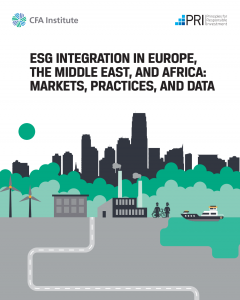
Download here: https://www.cfainstitute.org/en/research/survey-reports/esg-integration-emea
There is no “one best way” to do ESG integration and no “silver bullet” to ESG integration.
- Investors should focus on ESG analysis, not ESG investing. ESG investing is often used as a marketing slogan, whereas ESG analysis is a fundamental part of investment analysis and requires a disciplined and tangible approach to be fully integrated into the investment process.
- Governance is the ESG factor most investors are incorporating into their process. Although environmental and social factors are gaining acceptance, they are starting from a low base.
- ESG integration is more advanced in equities than fixed income.
- Although portfolio managers and analysts are more frequently incorporating ESG into the investment process, they rarely adjust their models based on ESG data.
- The main drivers of ESG integration are risk management and client demand; the main barriers to ESG integration include a limited understanding of ESG issues and a lack of comparable ESG data.
Methodology
In preparing these reports, we collected data from several sources, including:
- an ESG integration survey of 1,100 financial professionals, predominantly CFA Institute members. The survey ran from September 2017 to July 2018;
- workshops organized by CFA Institute, PRI, and 23 CFA® Societies that ran from October 2017 to April 2018;
- Bloomberg, which contributed two datasets—equity and fixed income—of its ESG disclosure scores for 17 markets; and
- PRI’s 2017 reporting framework, which collates the ESG practices of practitioners around the world.
To better understand how ESG factors impact the capital markets (share prices, corporate bond spreads, and sovereign debt yields) and how frequently investors do and do not integrate ESG data in their investment analysis and process, the firm YouGov was commissioned to administer a global survey on ESG integration [YouGov] The survey asked questions to gauge investor attitudes toward ESG integration as well as to obtain a better understanding of how ESG integration is done in practice.
Research was carried out among stakeholders in 17 different countries.
The findings for respondents in the EMEA region are based upon 392 completed surveys from respondents based in:
- France (n=37);
- Germany (n=79);
- Italy (n=35) (Note: No separate chapter on Italy);
- The Netherlands (n=59);
- Russia (n=35);
- South Africa (n=43);
- Switzerland (n=51);
- The United Kingdom (n=51); and
- The United Arab Emirates (n=2).
We held 23 workshops to accompany the survey. Nine workshops were held in the EMEA region, including workshops in France, Germany, the Netherlands, Russia, South Africa, Switzerland, the United Kingdom, and the United Arab Emirates.
The purpose of these workshops was to provide color to the results of the survey.
Workshop participants were split into groups of six to eight and discussed and contributed their views on the preliminary results of the survey. From the workshops, we were able to collect insights from local practitioners who are predominantly non-ESG investment professionals.
Looking for more research and resources on ESG? Check out our ESG Investing and Analysis hub.







